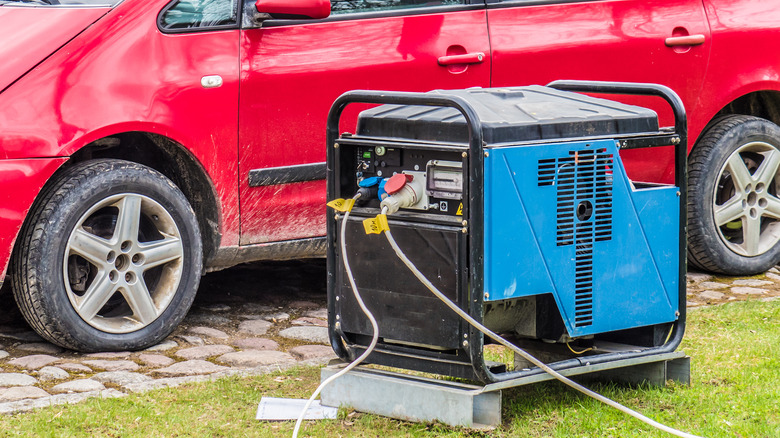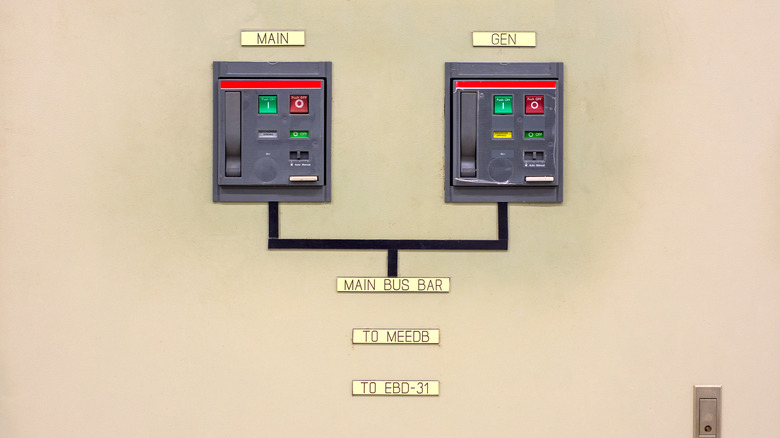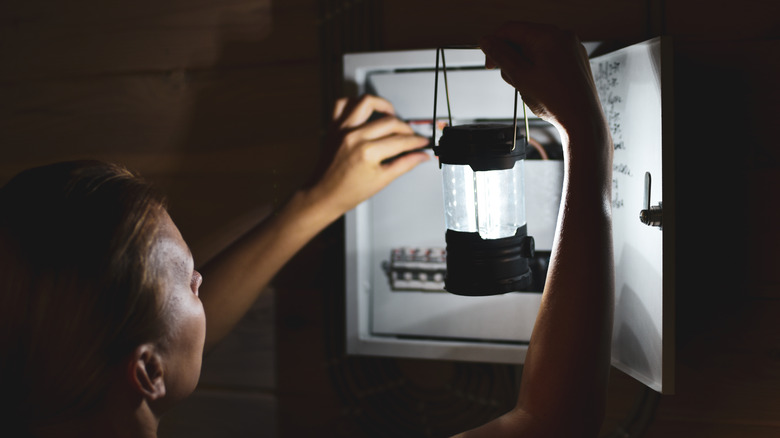The Right Way To Hook Up A Portable Generator To Your House
As the news of natural disasters and related power failures increases, you may be one of the many Americans investing in a back-up generator. Portable generators are the cheapest option but they come with several caveats. First, any mention of portable generators must come with a warning about carbon monoxide (CO), the poisonous gas they produce and release into the air. Hundreds of people die from CO poisoning annually and thousands more are hospitalized, reports the CDC, so it is crucial that you never run a portable generator indoors, even in a garage. Ideally, place it outside at least 20 feet from any doors or windows into your home.
Because your generator will be outside, you'll need a system in place to safely get power to your home circuits. In the short term, it's possible to use outdoor-safe cables to run an extension cord from the generator into the home, but this isn't ideal. As noted by Your Power Guide, this approach creates tripping hazards, doesn't utilize the full potential of your portable generator, limits how many appliances you can power, and probably won't work for hardwired circuits such as lights.
In order to make the most of your portable generator, especially during extended power outages, you need to install a permanent power transfer system between your generator and your main circuit breaker box. It is strongly recommended by Consumer Reports that you hire a professional to install a transfer switch — in some jurisdictions, this is a legal requirement.
Transfer switches
Per Honda, a transfer switch changes the flow of electricity from your home's electrical panel to your home generator. It aids with electricity management and makes it possible to power your entire home with the use of a portable generator when necessary.
According to NerdyNaut, an automatic transfer switch does cost more than the manual option, but it will automatically detect a loss of main power to your home, switch to generator power, and prioritize the correct circuits in the case of a blackout. It is a complex electrical system and, as such, should be installed by a professional. However, it's a good plan for you as the homeowner to decide which circuits and appliances are crucial to prioritize so that the automatic transfer switch can be programmed with your preferences from the outset.
Some regions mandate that all generator use happens via a transfer switch for safety reasons. In non-residential areas, automatic transfer switches are installed where a loss of electricity supply could present a danger to life, safety, or equipment, such as hospitals and data centers, according to Professional Electrician & Installer. These systems require upfront investment and installation, but for that money, you will get peace of mind and an uninterrupted supply of power in return.
Interlock switches
A lower-cost, lower-tech option to link your portable generator to your home breaker box is to have an interlock switch installed. However, it is both illegal and extremely dangerous to have both main and generator power going into your home circuits simultaneously. As Upgraded Home explains, this can lead to electrocution of power-line workers, electrical fires in your home or wider neighborhood, and overloading the portable generator itself. An interlock switch is a bar that physically prevents both of the breakers for main power and generator power from being open at the same time. They can both be turned off, but the interlock switch blocks both of them from being turned on.
Even though interlock switches seem like a simple option, they still ought to be installed by a professional electrician, who can let you know if you're even allowed to install this type of switch in your home before doing so. According to Portable Power Guides, they are against code in some areas — especially residential zones.
Interlock switches are a basic failsafe, but they leave a lot of potential pitfalls to ponder. Carelessly switching on all breakers across the board can overload a small generator, so be sure to go one circuit at a time. Switching back to main power has to be done manually also, so skimping on installing interlock switches can cost you in wasted fuel and time, as well as shortening the overall lifespan of your generator.


